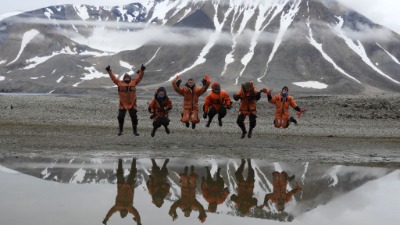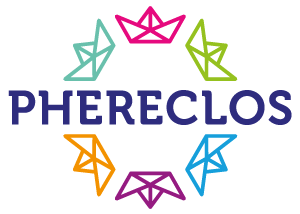EDU-ARCTIC
- Poland,The project was implemented in 59 countries in total.
- 2016

| Time frame | |
| Categories | |
| Level of Schools | |
| External Partners | |
| Type of Schools | |
| URL | |
| Number of Schools involved | |
| Number of Schoolheads involved | |
| Number of Teachers involved | |
| Number of Students involved | |
| Number of Parents involved | |
| Number of External Partners involved |
“EDU-ARCTIC” is an innovative educational program attracting young people to natural sciences and polar research. The project aims to establish strong links between the research and education communities by connecting schools participating in the project to scientists at Arctic research stations and research institutes throughout Europe. Students participating in the project will have a unique possibility to get to know what scientific careers are like and learn more about different research disciplines while learning how to apply the scientific method and learn crucial problem-solving skills.
The most important objectives were:
1) enhancement of knowledge about science and scientific research, as well as their place in the modern world, familiarizing young people with scientific career opportunities;
2) enhancement of knowledge about nature, geography, natural resources, history, social and political specificities concerning polar regions and increase of sensitivity to environmental issues and climate change;
3) establishing strong links between the worlds of research and young people/ society in order to increase their ability to understand scientific messages and scientific language;
4) increase of the number of young people, especially young girls interested in STEM and scientific careers;
5) introduction of innovative tools by way of an e-learning portal and effective methods of teaching
science in schools.
All the project resources, online lessons recordings, POLARPEDIA terms and hands-on activities are available for everyone without limitations. According to project replication strategy, funding is searched actively to develop project activities within new formulas.
The project implementation was based on 5 main components:
1) Broadcast (transmission) of online lessons from polar stations and other research places connected with the sciences and polar research;
2) “Polarpedia” –– an online multilingual encyclopedia with scientific expressions, containing educational resources;
3) Arctic competitions dedicated to individual students cooperating with teachers; winners participated in polar expeditions;
4) Monitoring system – meteorology and phenology registration program, both web-based and mobile
5) Teacher workshops and training sessions.
The EDU-ARCTIC project was funded entirely by the European Commission within Horizon2020. Replication strategies assume searching for new funds, namely national, regional and international funding schemes. In March 2020, national funding was acquired by Project Leader (Institute of Geophysics, Polish Academy of Sciences, funded by Ministry of Science and Higher Education), along with an almost finalized agreement with the National Agency within EEA funding scheme.
1) Online lessons: In total 532 lessons were conducted with 5026 participating groups (schools).
2) 277 teams took part in Arctic Competitions.
3) Almost 500 terms in Polarpedia, online encyclopaedia with 16 language versions and educational resources (games and quizzes).
4) Introduction of mobile tools: 2 apps – Monitoring system app, allowing students to report meteorological and phenological observations; The Arctic Explorer – a quiz allowing not only to check one’s polar knowledge, but also to actively participate in its creation by submitting questions.
The implementation of EDU-ARCTIC, even though thoroughly planned, was mind-opening on many levels. Firstly, it showed a dedication of teachers from countries as seemingly far from polar issues, such as Albania or Greece. Secondly, the project proved to have actual impact on groups and individuals: their choice of educational path, considering scientific career or even inspiring young people to travel and discover polar areas. Thirdly, it showed the power of project co-creation: students and teachers became co-creators of the project, via their feedback, involvement and loyalty. One of the examples of such interaction was the mobile app “The Arctic Explorer” quiz, which was a bonus activity, initially unforeseen, proposed by a 13-year-old student from Faroe Islands, who was a contestant in Arctic Competition. Students’ and teachers’ creativity inspired project staff on daily basis and pushed them to acquire new abilities. Inspirational stories of students were extremely rewarding.
Also, even though it was not required to produce any publications as a result of our activities, as EDU- ARCTIC was an educational initiative and not a strictly scientific/research project, it turned out eventually that the implementation of EDU-ARCTIC brought a lot of experiences presented in 4 publications.
The EDU-ARCTC programme, due to its international character, was based mainly on online activities, mostly online lessons with the use of teleconference system; some of them were organized as an online thematic course focused on particular issues, such as e.g. engineering and technology. Online lessons were based on two-way communication and facilitated direct contact with experts from various domains. Selected lessons were co-created by students (with a use of so called “flipped classroom” method), other used modern online tools not only to test students’ knowledge and increase their involvement (such as KAHOOT quizzes), but also online survey tools, allowing students to steer the lesson and participate more actively. Within The Arctic Competition component, students had to elaborate an innovation or a research project, which introduced inquiry based education organically. The Arctic Explorer App is an example of both: use of modern tools and participatory approach, as the idea of the app came from 13-year-old student, who was a contestant of the Arctic Competition.
One of the innovative aspects of the project, other than use of digital tools, is the endeavour of making science more approachable. This was introduced through making scientific language more understandable by the general public (see: multilingual encyclopaedia – POLARPEDIA.EU). More importantly, the project fostered two-way communication between scientists and non-scientists becoming a mean of dissemination of research results, much desired by scientists.
One of the innovative aspects of the project, other than use of digital tools, is the endeavour of making science more approachable. This was introduced through making scientific language more understandable by the general public (see: multilingual encyclopaedia – POLARPEDIA.EU). More importantly, the project fostered two-way communication between scientists and non-scientists becoming a mean of dissemination of research results, much desired by scientists.
The users’ feedback was a crucial factor That shaped the project.
In particular, 3 EDUCATOR Forums
In 3 different countries, (project partners) were organized, during which active Teachers were requested to share their ideas on various program components.
As a result, for example, the mobile version of the monitoring system was designed and developed, by which Students could be engaged directly.
Consortium partners learned from each other, benefitting from different expertise. Moreover, the project established especially strong links with 11 European projects. Some collaborations resulted in strong progress in the exploitation of results and in a follow-up proposal. The Consortium developed noted links with 80 various institutions, including educational and scientific institutions, governmental institutions, international associations and others.
68 networking events were organised to share experiences practically worldwide.
The project methodology, based on online tools mostly, removes common barriers that are faced by people from e.g. geographically under-privileged, remote regions. Moreover, one of the projects’ aims is to erase gender inequities in science, namely to encourage especially young girls to pursue scientific career paths in STEM, by showing female role-models and using gender-sensitive language, for instance.
As for ethical aspects of the project, taking into account that project evaluation was conducted thoroughly, important factors related to data protection were analyzed. Consequently, detailed procedures were developed and accepted by the European Commission.
The EDU-ARCTIC project is focused on polar research, which is, in its nature, interdisciplinary, including, to name a few of the disciplines, Earth sciences, Life sciences and Social sciences.
By presenting career paths of polar researchers working at polar research stations (for example, Polish Polar Station Hornsund), as well as their everyday life and work, the project combined scientific knowledge and its practical application. The Arctic Competitions contestants also had to apply such approach, for example while designing innovative solutions for polar researchers.
The whole construction of the Project Consortium, decision making processes, constant contact (personal, when possible, and online on regular basis) were aimed at close cooperation and valuing every partner’s contribution with unique competences, knowledge and background.
The EDU-ARCTIC project focused on the Arctic region, which is the most vulnerable area in terms of global climate changes. It was emphasized on many occasions that not only the Arctic reacts strongly to global changes, but it also has a strong impact on climate, landscape and living conditions worldwide. On the other hand, many topics tackled issues of anthropogenic influence on climate, air quality, water quality, food webs, ecosystems and pollution levels (including, e.g., microplastic and nanoplastic pollution).
The whole construction of the Project Consortium, decision making processes, constant contact (personal, when possible, and online on regular basis) were aimed at close cooperation. The ownership of the project result is shared by all the partners.
The general objective of the EDU-ARCTIC project is a cross-country adaptation of innovative practices in science
education in Europe, achieved thanks to the innovative online tools. The interactive, open-access tools are available for everyone, thus the project contributes to fostering digital citizenship, also to citizen science performed via mobile app.
At the beginning of the project implementation, two major documents were prepared: Consortium Plan - project handbook/guide for all Partners on the project’s implementation. In particular, they focused on the description of the EDU-ARCTIC organization and on the management structure and Project Quality Plan, providing quality measures & procedures for the purpose of quality assurance. They described the quality control procedures to be applied throughout the project's duration, which are meant to facilitate co-operation within the consortium and assure the quality of the work to be carried out.
As project consortium was relatively small, therefore direct and regular contact with the dedicated team in each partner institution was a key to smooth performance.
Each partner was represented during General Assembly, the main decision-making body. There were 6 Consortium meetings in total, one at each partners’ premise plus methodological workshops at the beginning of the project, allowing to elaborate key steps in project implementation. Additionally, internal reporting was required, followed by online meetings every 2 months. Openness and flexibility were the key, as well as clear rules in terms of documents circulation, deadlines, reports’ reviewing etc.
There were 5 other partner institutions in the project consortium. Each partner brought its own expertise in e.g. IT, promotion and dissemination and also various STEM domain (geology, social aspect of research, nature conservation, renewable energy etc.). The project established especially strong links with 11 European projects. Some collaborations resulted in strong progress in the exploitation of results and in a follow-up proposal. The Consortium developed noted links with 80 various institutions, including educational and scientific institutions, governmental institutions, international associations and others. They were crucial to the recruitment of schools, but also for the sustainable use of project resources (for example SCIENTIX project accepted EDU-ARCTIC resources as a part of its repository).
The project contributed to institutional learning in terms of e.g. governance and science communication at the Leading Institution. A special board was also established at the Leading Institution in order to provide unbiased evaluation of the project from an ethical point of view.
The core implementation team consisted of representatives of all partners, involved on daily basis in project performance.
Project evaluation and monitoring were separate work packages. Each element of the programme was evaluated based on users’ feedback, including detailed surveys on project outcomes. The KPIs were monitored and all of them were achieved with much greater numbers than originally predicted.
